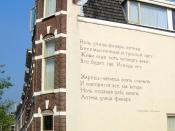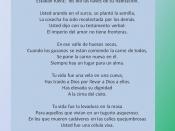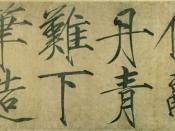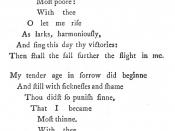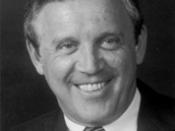The Sound of a Memory Poetry allows people to express their feelings in ways that regular texts cannot. By carefully choosing each word and arranging them on a page, like an artist blending together colors on his canvas, a poet can make readers see, and feel, things that a normal author cannot. Mark Rudman's poem "Chrome," uses carefully chosen words that help to set the pace at which the poem is read aloud. In turn, this tempo helps to create an image, and animate it. Mark Rudman's use of poetic tools create a poem that is strong in imagery. This is because the poem's sounds directly reflect that of the actual events of which Rudman is speaking of.
The opening of Rudman's "Chrome" is read aloud at a steady, medium pace. The author is reflecting upon youthful memories of his motorcycle riding days. These memories are triggered by a news broadcast on the authors TV.
He uses alliteration to help set a tone that will be repeated again and again throughout the poem. Phrases like "hundreds of helmeted riders," and "tearing up holes of desert turtles," use alliteration to create a smooth flowing, connected sound. The mood is calm and peaceful, yet descriptive. The reader's can see the same things that the author sees in his own mind, and a calm feeling is felt throughout the opening lines.
Rudman then throws in some quicker wording to describe the landscape, which is broken up into short, incomplete ideas with commas. He introduces a multitude of ideas when he describes, "Hills leeched of color,// the desert a kind of form,// with rimrock and succulents and gulches// providing borders- boundaries.// Dust and Desire" (651). The above lines are very interesting when you look at the tempo at which they are read. "Hills leeched of color," is on a line by itself and it's followed by a pause. After the pause, a comma, a new idea begins. It is read quickly, and then there is nothing. He repeats the process with, "the desert a kind of form." Both lines are incomplete sentences alone. They are quick flashes of an image which disappears as quickly as it came. The next idea forces readers to pick up the pace a bit because of it's larger length and the pause comes later. This idea reads, "with rimrock and succulents and gulches// providing borders- boundaries" (651). Once again a feeling of incomplete ideas, flashes of an image, and then something brand-new. This is the exact same thing you experience when riding at high speeds off-road on a Honda 125. You see what lies ahead, nothing else. You see something ahead of the bike. Is it an obstacle, or an opportunity? Do you break? Or do you gas it? Nothing real exists, nothing except you, the bike, and the terrain. The ride's fast paced, and you don't have time for a complete thought. All that you know, all that is real, is "Dust and Desire." I think that Rudman's use of wording is absolutely fabulous and it sets the tone exactly. The reader does not slow down until he or she reaches "borders- boundaries." Notice the alliteration of the "b" sound. When Rudman uses a pause, along with alliteration, you know that he obviously wants you to make a connection. In this case, it's his attitude toward the desert's borders. These borders are the boundaries between the desert that he obviously loves, his escape, and the real world that could not follow him into the desert.
Now that Rudman has introduced the backdrop for the ride, he reveals his passion for it, "O sweet sixteen, to be sprung again and again against// the rock-studded sand, the danger not in the desert but around it" (651). Again we see alliteration used throughout the quote. The "s" sound in "sweet sixteen," or the "d" in "danger not in the desert," pulls the idea together. And it keeps a steady, smooth sound that is pleasant to the ear. It is not hard to imagine the sound of the tires in the sand, or the harshness of a 2-stroke engine pulling through an otherwise silent landscape. The word sounds are flowing and seamless, just like the bike climbing and descending dune after dune. He continues with "The body's oneness with the mind// on the lean machine seemed just right, the body// soaring while hovering close to the sand..." (651). This quote introduces some internal rhyme to the poem with "lean machine." Obviously these words are connected to begin with as "lean" being an adjective describing the noun, "machine," but the rhyme even pulls them closer. Another word trick that I found interesting was the use of the word "soaring." It has a soft sound that is somewhat long and drawn out. It gives you that light, floating feeling of being in the air on his Honda, but the instant it grabs dirt the poem takes off with, "close to the sand as the Honda 125// jounced past yucca and cactus and took// the long dip into the arroyo where the ring of distant chimney rocks and hills// like space stations receded..." (651-652). At this point the reader is again overwhelmed with quick, flashy images, and a multitude of ideas. Rudman even throws readers a curve-ball by using simile when describing the landscape. This restored quick pace, is very appropriate for following up a "soaring while hovering" situation. As any rider will testify, the jump may be peaceful, but the moment your tires touchdown, and your suspension compresses under the landing force, there is a split-second of terror and confusion where all focus is on a million variables which must be successfully negotiated if you don't want to become part of the landscape. What better way to make a reader feel this terror and confusion then by handing them six lines of text without so much as a comma! From this point on in the poem, the tempo is noticeably faster, and the action and tension builds as we move from one event to the next.
Since Mark Rudman has been slowly increasing the pace of the poem, one cannot help but to feel that a resolution is to come. There must be a climax. That climax, is Rudman's close encounter with death. Rudman tells about the time that he "took// a horseshoe curve at 50 and approached// an even sharper one- the slender cycle shaking apart- ;// and [he] wondered what to do, like Porthos// going back to the bomb he'd planted to make sure// he'd lit the fuse... when- BOOM!- ;" (652). Rudman uses a fast pace to parallel the speed of the bike, and he uses yet another simile to compare his situation to that of one of the three musketeers. The escape from the real-life crisis, to the fantasy world of Porthos, doesn't have a desirable outcome. So it's safe to say that it offers readers little hope for Rudman's situation. However, Rudman is an old man, reflecting back on this experience, so we still know that he must have somehow found a way out of this predicament.
How did Rudman escape? Rudman remarks that, "I let go of the throttle- threw up my hands- // and the bike went off the highway, keeled over// and died at the cliffs edge" (652). Ok, so it wasn't years of experience, a remarkable, or even sane thought of his, or even a shred of skill which saved him, but simply the fact he did nothing. By simply giving up any attempt at control, Rudman brought the tempo of his bike, and of the poem to a halt. Rudman closes by saying that, "I owe my life to letting go" (652). This line contains alliteration of the "l" sound, assonance of the "o" sound, and perhaps some internal rhymes between "owe" and "go." This ending fits the rhythm of the poem perfectly. It returns the reader to the calm, smooth pace of the intro. It resolves the conflict, and it brings us back into the present time. It is the perfect ending to a very visual and exciting poem which forces readers to read at a pace, and to create a mood, which reflects that which the author must have felt when these events took place. And all of this would have been nearly impossible, had it not been conveyed to the reader in the form of a poem.
Work Cited Rudman, Mark. "Chrome." Literature: The Evolving Cannon. Ed. Birkets, Sven P.
Needham Heights, Mass: Allyn and Bacon, 1996. 651-652.
